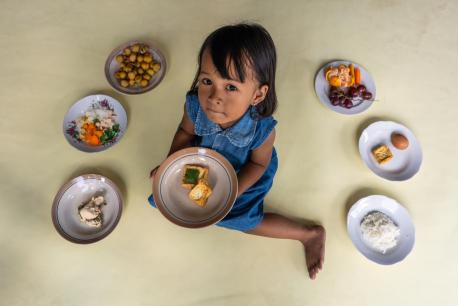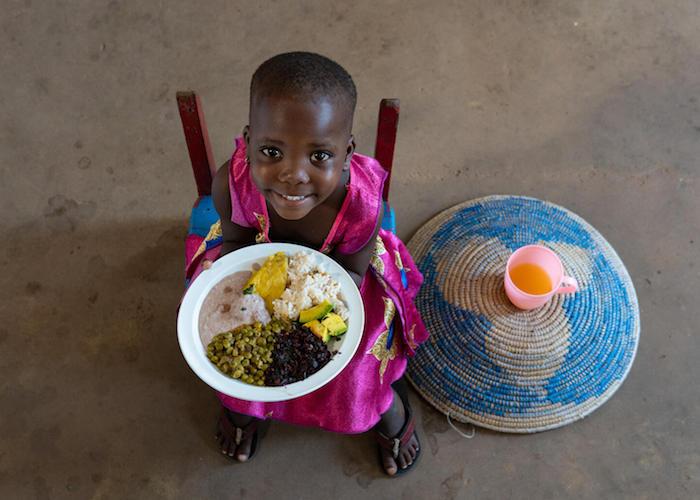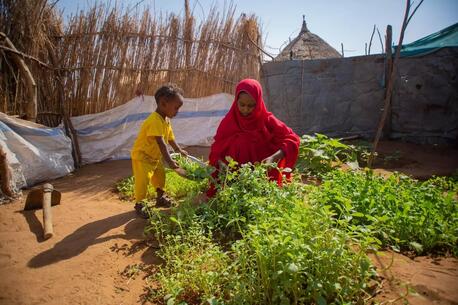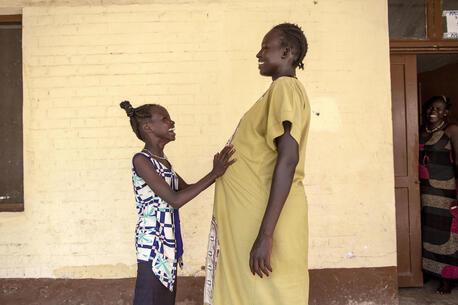
Fed to Fail? UNICEF Report Shows Global Crisis in Children’s Diets
The world is failing to feed children nutritious foods — putting millions of children at risk of irreversible harm, according to a new UNICEF report. But change is possible. UNICEF is advocating for bolder action and greater accountability to protect and fulfill the right to food and nutrition for all children.
A growing number of children under the age of 2 are not getting the food or nutrients they need, according to the latest evidence detailed in a new UNICEF report.
Fed to Fail? The crisis of children’s diets in early life, an analysis of data from 135 countries and territories representing more than 90 percent of the global population of children under 2, reveals that only half of all children between 6 and 23 months old are being fed the minimum recommended number of meals a day. And only about a third consume the minimum number of food groups children need to thrive.
In short: children’s diets are failing in terms of timeliness, meal frequency and diet diversity.

Laxmi Chhetri feeds her 3-year-old son, Aarav, on the terrace of her parents' home in Gaidakot, Nawalpur District, Nepal. Aarav spent nearly a month at a UNICEF-supported nutritional rehabilitation home after he was found to be suffering from severe acute malnutrition. Aarav received treatment while his mother learned about different cooking and feeding techniques. © UNICEF/UN0519420/Upadhayay
"When the stakes are highest, millions of young children are being fed to fail,” said UNICEF Executive Director Henrietta Fore. “Poor nutritional intake in the first two years of life can irreversibly harm children’s rapidly growing bodies and brains, impacting their schooling, job prospects and futures ... the ongoing COVID-19 disruptions could make the situation much worse."
In the report, UNICEF identifies barriers to accessing nutritious food and outlines a course of action for governments, urging greater collaboration among decision makers to strengthen systems, reform national policies and support parents and families in order to address the crisis.
The COVID-19 pandemic exacerbated difficulties families face in feeding young children
Evidence suggests that millions of families — many of whom were already struggling — are finding it even more difficult to feed their children nutritious and diverse diets as a result of COVID-19 containment measures and other pandemic impacts, including lost income and reduced household spending.
As a result, the percentage of children consuming the minimum recommended number of food groups fell by one-third in 2020 compared to 2018, from 81 percent to 55 percent.
The COVID-19 pandemic also continues to disrupt essential services such as nutrition counseling and social protection systems, derailing efforts to improve children’s diets.
Disparities in diets persist across and within regions
The child feeding crisis is affecting children in all regions of the world, the report notes, but young children living in rural areas, poorer households and disadvantaged regions within countries have the least diverse diets.
The relatively high cost of nutritious foods is one of the greatest obstacles to families: almost 80 percent of mothers in focus group discussions reported that they struggle to afford nutritious foods for their children.
Shortages in national supplies, seasonal scarcities and poor road infrastructure also continue to constrain physical access to nutritious foods, particularly in rural sub-Saharan Africa, in remote settings and in countries affected by climate shocks or conflict.
There is not enough money in our house to buy different foods for my child, and even if I did have the money, the food is not available.
A mother in rural Ghana described how poor affordability and physical access can overlap: “There is not enough money in our house to buy different foods for my child, and even if I did have the money, the food is not available.”

In Uganda, Betty, 3, sits in her favorite chair with a nutritious meal of rice, matooke (banana mash), groundnut paste, red leafy vegetables, avocado and peas. © UNICEF/UN0509184/Abdul
Change is possible, even in the poorest contexts
Achievements in child nutrition over the past decade show that positive change is possible, given the progress that has already been achieved, UNICEF argues in Fed to Fail.
Malnutrition in children under age 5 has declined drastically since 2000. The global prevalence of child stunting is down by one-third and the number of children with stunted growth has been reduced by 55 million. This is significant.
And in ten countries where UNICEF works – Bangladesh, Burkina Faso, Cambodia, Côte d’Ivoire, the Gambia, Kyrgyzstan, Maldives, Nepal, Sierra Leone and Timor-Leste – the percentage of children receiving a minimally diverse diet has increased by at least 10 percentage points in the past decade.
But as the report also notes, progress has stalled. Bolder action and greater accountability will be needed to improve children's diets going forward.
A call for bold action and greater accountability
To protect and fulfill the right to food and nutrition for all children — a legal obligation under the Convention on the Rights of the Child treaty — UNICEF urges governments, in collaboration with national civil society, development partners and the private sector, to:
- mobilize food, health and social protection systems to deliver nutritious, safe and affordable diets, essential nutrition services and positive nutrition practices for every child
- strengthen coverage and quality of nutrition services, including caregiver counselling on child feeding
- improve availability and affordability of nutritious foods, including fruits, vegetables, eggs, fish, meat and fortified foods, by incentivizing their production, distribution and retailing
- implement national standards and legislation that protect young children from unhealthy processed and ultra-processed foods and beverages and end harmful marketing practices targeting children and families
- increase the desirability of nutritious and safe foods through multiple communication channels, including digital media, to reach parents and children with easy to understand, coherent information
- position young children’s right to nutritious and safe diets as a priority in the national development agenda
- ensure coherent policy support and legislation across sectors and systems

Nurayim, 3, holds a plate of nutritious food at her home in Kurshab village, Uzgen district, Osh Oblast, Kyrgyzstan. Her mother tells us that she adapted well to eating food that the rest of the family eats, including dairy products, meat, fish, poultry, eggs, fruits and vegetables. The family avoids unhealthy foods in every way possible, she says. © UNICEF/UN0519272/Zhanibekov
At the 2021 UN Food Systems Summit, some 300 commitments were made — by governments, civil society groups, farmers and others — to accelerate action and to transform food systems. The summit was also an opportunity for stakeholders to listen to children and young people, and to have their voices heard — a critical part of the process and a UNICEF priority for building long-lasting solutions.
Read the full report to learn more.
Change is possible to ensure all children benefit from a nutritious, affordable and sustainable diet. Join a Summit Action Track.
Top photo: Gelsi, 3, holds a plate of tofu at her home in Paseban Village, Klaten, Central Java Province, Indonesia. © UNICEF/UN0517588/Ijazah


